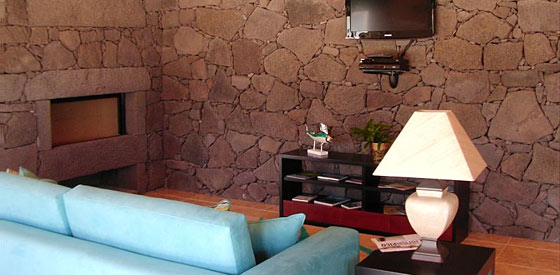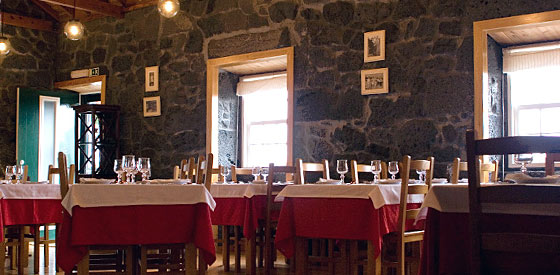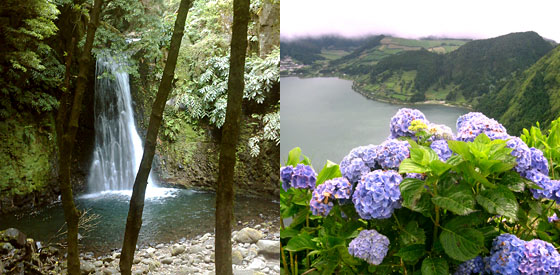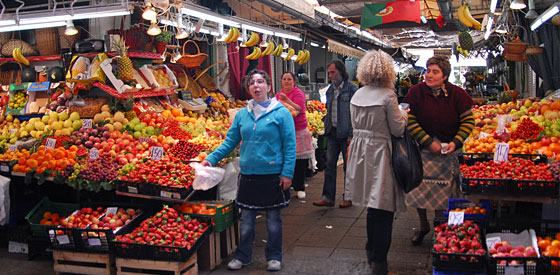1. Where to Stay

Reside among locals at the Hotel do Colégio (from $132), a 55-room former music academy set amid Ponta Delgada’s cobblestone streets and elaborate churches. Browse the hotel’s gourmet shop for local honeys and Azorean teas from Goreanna ($3-8), Europe’s only tea plantation.
Overlook the ocean from the flower-covered Caloura Hotel (from $128), an 80-room resort nestled above a private rocky beach that’s also home to a dive center, gym, sauna, and tennis courts. Forgo the overpriced in-house restaurant in favor of the second-floor bar, where you can watch the sun set over the water.
Admire panoramic views of Pico Mountain from a second-floor room at Baía da Barca (from $128) in Pico. A series of volcanic trails begins a few yards from the property, and the windswept Atlantic Ocean is less than 50 yards away. Still, don’t miss the luxurious pool and Jacuzzi, where locally brewed Especial is the drink of choice.
2. Where to Eat

Ditch Sao Miguel’s trendier spots for Restaurante Adega Regional (Rua do Melo, 70/72; 296-284-740), a bustling mom-and-pop joint scattered with wooden tables and green-and-white-checked tablecloths. Order the specialty, lapas grelhadas: a cast-iron skillet heaped with oven-roasted limpets on the half-shell. Wash it down with bottles of vinho de cheiro ($7), the favored local red wine.
Sit on the terrace for ocean views at O Ancoradouro (Rua João L. W. Terra, 9950; 292-623-490) on the outskirts of Madalena. Though the menu is dominated by fresh-caught seafood, the linguiça ou chouriço com inhame (yam and pork sausage) is a regional standout. Pair your meal with ice-cold verdelho wines ($7-30), a white varietal that thrives in Pico’s volcanic soil.
Splurge on an Azorean feast at the upscale Canto do Paço in Prainha after a gorgeous 45-minute drive down the island’s lava-strewn coast. Call ahead to reserve the cavaco, an endemic crab served with onion and green pepper in a vinegar-based sauce—they sell out quickly.
3. What to Do

Follow a local naturalist on a four-hour trek along São Miguel’s dirt roads, lined with Japanese cedars and hydrangeas (Country Walkers offers Azores tours starting September 4). The hike includes a plunge in the hot geothermal tidal pools at Ponta da Ferraria, a visit to the Goreanna Tea Plantation, and a swim under the cool Salto do Prego waterfall.
Set off on a three-hour hike from the nineteenth-century town of Furnas to the Lagoa das Furnas, the highest lake above sea level, where locals pot-cook traditional meat dishes called cozido das furnas over the geothermal steam rising from cracks in the earth. Follow the rim of the lake until you reach the late Gothic-style Nossa Senhora das Vitórias, an ornate, seventeenth-century chapel. Afterward, reward yourself with a steamed corncob from one of the Furnas street vendors.
Conquer the 2,351-meter, eight-hour round-trip trek to Mount Pico, an active volcano and the tallest mountain in Portugal (Futurismo, $167/day; guides are mandatory). Climb past acacia, laurel, and Australian cheesewood forests before funneling into Prainha Forest Park, surrounded by moss-covered lava walls. The trail empties out at Baía de Canas, a small basalt rock beach ideal for a post-hike swim.
4. Insider’s Tip

Azoreans take pride in their greenhouse-grown pineapples, which are more acidic and fragrant than North American variety. The fruits make ideal gifts, but make sure to ask for a pineapple that has a pre-clearance certificate issued by the food and drug administration in the Azores—only certified pineapples will be accepted by U.S. Customs upon entry. (You can also buy an FDA-certified fruit at the Ponta Delgada Airport.)
5. Oddball Day

Take a 50-minute flight ($90 from Ponta Delgada) or a 75-minute ferry from Pico ($15 on Atlanticoline) to the island of Faial, a must-see for any Azores first-timer. Start with an espresso and a plate of vésperas—rich éclairs unique to Faial—at the Ponto Come pasteleria and gelateria (Travessa de São Francisco, No. 9; 292-392-623). Next, take a short taxi ride to the subterranean Capelinhos Interpretation Center, an ultramodern volcano museum devoted to the complex geology of the islands; the structure was built on the site of a 1957 eruption, beneath a lone surviving lighthouse. Work your way back to the yacht town of Horta to browse the colorful drawings of ships covering the marina—the artwork has been painted by hundreds of superstitious crews since the eighteenth century who believe it’s bad luck to leave without adding your ship’s name to the wall. Then cool down with a gin and tonic at Peter Café Sport, a nineteenth-century British nautical pub that serves burgers and sandwiches. Afterward, poke through hundreds of pieces of curious artwork carved on whale’s teeth and jawbones at the Scrimshaw Museum (Rua da Fonte do Rego 21; 292-292-327), founded by Peter Sport’s late owner. Finally, take a swim in the crystal-clear waters of Algoa Municipal Park, a fifteen-minute walk south of the marina, before heading back on the ferry.
6. Links
Azores.com offers an island-by-island breakdown of the archipelago.
Research the cuisine and festivals of each island at Destinazores.com.
Trails Azores is a bilingual website with detailed maps and terrain information for hikers.
One of the biggest ferry networks on the Azores can be found at Atlantico Line.